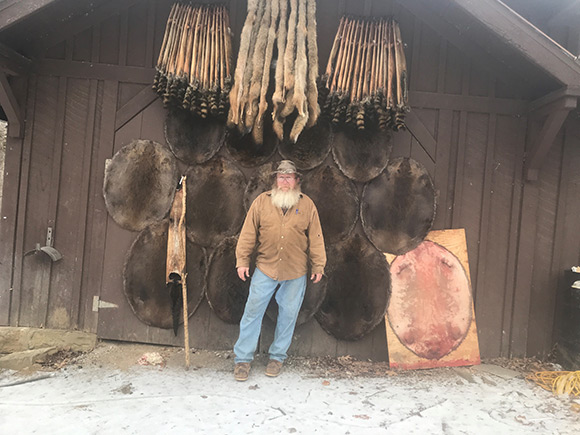 Team Fur News - August 2023
Team Fur News - August 2023
Big Jack
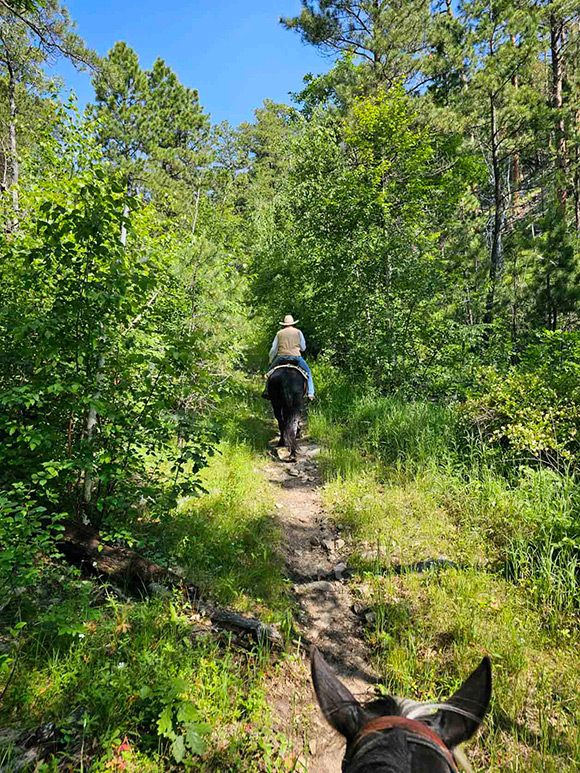
FUR-FISH-GAME editor, John D. Taylor riding Big Jack. - Lisa Buckley photo
Back in May when I was introduced to readers, you saw a guy in a cowboy hat on a gorgeous Tennessee Walking Horse mare. You might have guessed that, in addition to loving English setter bird dogs, I’m a horseman.
I love to ride horses. When I’m in the saddle, I feel like the king of the world. Explaining that sensation to those who haven’t ridden, it’s like the feeling you get after swimming in the ocean for a while – that relaxed, cool, sense of inner well-being, like everything is good and right with the world.
Well, there’s another horse in my corral. He’s a big, 16-hands-tall, black Tennessee Walking Horse gelding named Jack. We acquired him in October of 2022, mostly for my wife.
I’ve had some serious doubts about Jack. Time and other conspiracies limited previous riding to mid-winter classes in the Laramie County Community College arena. (Rather than build football stadiums, Wyoming colleges erect indoor horse arenas for rodeo athletes.) We hoped these classes would help us get to know Jack and vice-versa.
In the arena, he balked for Nancy, and later for me, at riding around the arena, doing circles and other requests. The classes were good, but a bit like going back to kindergarten for an older horse. Jack is 17. He’d oblige for a little bit, then quit. Ask him for forward movement and he’d back up, as if to say, “This is dumb, and I don’t like arenas.”
Well, after a recent ride in South Dakota’s Custer State Park, all doubts have been obliterated. Jack showed himself to be a fabulous trail horse.
On that ride, Jack stood at a mounting block steady as a rock (hated this in the arena); led a group of two other riders; followed other horses; crossed creeks; led others crossing creeks; followed crossing creeks; crossed wooden footbridges over creeks, climbed a bunch of serious hills – and for an older, out of shape horse did so very convincingly; let me mount from a couple rocks during breaks (at 16 hands I need extra height to get my foot in the stirrup); rode in heavy car and motorcycle traffic; was a PR horse…. He was amazing and I’m so proud of my boy.
I take no credit for this. His second owner, a vet — a small, thin man — used this big horse as his personal trail horse (we didn’t know this). Jack showed me why that day, earning his Lakota name, Sunka Wakan Sapa Waste (good black horse) a dozen times over.
Our ride began at the French Creek Horse Campground on a good note but ended up becoming quite the adventure.
We – Wyoming farrier Lisa Buckley on her paint horse Osiris (she shoed Ribbon and Jack the day before); her friend, American Horse Zephier, on Lisa’s gelding Cody; and I – wanted to do the Big Tree/Robber’s Roost four-hour trail. Official directions urged riders to take the Centennial Trail south, follow it until you hit the Wildlife Loop Road, then essentially loop back to the French Creek Horse Campground on connected trails. Sounds easy.
We ended up going north on the Centennial – my fault, although you’d think if you put a rising sun on your left shoulder in the morning that direction would be South. Somehow, that darn trail headed north. We rode the Centennial across creeks then up over an almost vertical mountainside, on a trail covered in softball-sized rocks. The horses navigated it just fine, but I’m glad Jack had a good bit of mane to hang onto pulling that awful incline.
When we realized we’d hit the Badger Clark Road instead of the Wildlife Loop, we had to figure a way out of the mess. The Heddy Draw trail connected with the Centennial Trail and would loop us back to camp, so we backtracked some, got back on the Centennial and kept an eye out for Heddy Draw.
Along the way, we passed a trail marked No. 1. That's it. No other signage. Just No. 1. (Most CSP trails are very well marked, but not this one.) We considered it, but since it wasn’t really marked, I feared it might be something else. Twice we went up and down a mountain over a seriously rocky trail, looking for Heddy Draw. We ended up at the Badger Hole Trail connection near Legion Lake. I don’t know how many miles away from the campground we were.
It seemed there was only one way out and back to camp: Follow Centennial to its intersection with two state roads in the 71,000-acre park, then hit the Heddy Draw Trail where it intersected with one of these roads. So, we rode that route, adding another 4.5 miles to the ride (see map) and climbing 6,000-foot Mount Coolidge, amidst some heavy auto traffic flying along the switchbacks.

Custer State Park (To view large map click HERE)
At Mt. Coolidge’s summit, there is a pull-off/tourist overlook. My hips, my riding Achilles heel, already splayed from Jack’s big barrel, were simply done in from the four-hour ride (which had turned into six hours over very rough terrain). I hurt, and had to call it quits. Jack had had enough, too. So, Lisa and American Horse said they’d continue on, bring my truck and horse trailer up to me when they got back to camp.
For the next hour and a half, Jack was admired, petted and fussed over by tourists stopping at the overlook. One nice family asked if Jack had any water. (He’d drunk from a creek earlier.) They wanted to give him some, so they emptied a big square container, filled it with water and Jack guzzled it down. When he was done, he drooled slimy green flotsam back into the container.
I apologized, but the people said it was okay. “Well, at least you’ll have a good story for when you get home,” I said. They laughed.
When American Horse arrived with my truck and trailer, we loaded Jack and my saddle, I drove him back to camp, wished Lisa and American Horse a good ride the next day, and called it a day. I had another hour and a half drive to get home in Box Elder. I don’t know how many miles we rode altogether, but it was a lot. And that Jack, who I'd been doubting for nearly a year? He did great.
Pheasant season outlook bright in North and South Dakota
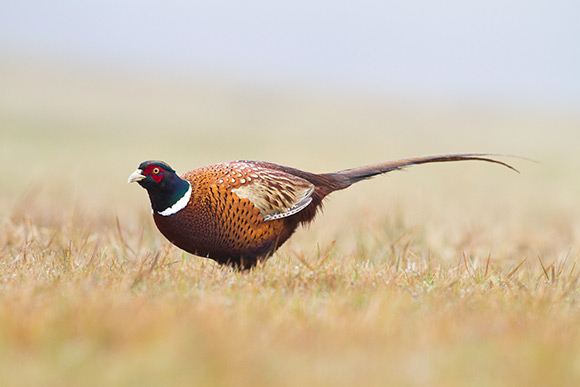
Pheasant - June Gathercole/Unsplash photo
In North Dakota, the number of roosters heard crowing during the state Game and Fish Department’s (NDGF) spring pheasant crowing count survey was up 30% statewide.
R.J. Gross, NDGF upland game management biologist, saw an increase in pheasant density, with high reproduction rates for most of the state, despite heavy winter snows. Regionally, pheasants showed 19.5 crows per stop in the southwest, up from 14.1 in 2022; 16.6 crows per stop in the northwest, up from 13.7; and 12.8 crows per stop in the southeast, up from 9.7. The northeast, not a primary pheasant range, had 3.3 crows per stop, up from 3.0 last year.
Crowing counts are conducted statewide each spring. Observers drive specified 20-mile routes, stopping at intervals to count the number of roosters crowing over a 2-minute period. Tallied, this information compared to previous years’ data can shows trends. Current conditions are excellent across the state, Gross noted, with adequate moisture, which fosters insect hatches and provides chick food. Pheasant chicks hatch from early June through late July. Much of nesting success will depend on the weather. The agency will more accurately assess pheasant production during its end of July roadside counts.
Across North Dakota in 2022 pheasant, sharptailed grouse and Hungarian partridge harvests were up from 2021. This surprised Gross, because statewide spring blizzards in 2021, followed by rain, should have reduced bird numbers. The harvest increase indicated good reproduction, and brood survival – a benefit of a warm, dry late summer with abundant insects.
During 2022, more than 51,000 pheasant hunters (up 9%) harvested nearly 287,000 roosters (up 10%). Counties with the highest percentage of roosters taken were Hettinger, Divide, Bowman, Williams and Stark.
More than 20,000 grouse hunters (up 29%) harvested nearly 63,000 sharptails (up 37%). Top counties were Mountrail, Burke, Bowman, Divide and McKenzie.
Some 19,000 Hungarian partridge hunters (up 36%) harvested nearly 55,000 Huns (up 22%). Top counties were Mountrail, Ward, Bottineau, Williams and Divide.
A spring crowing count video is available at https://www.youtube.com/watch?v=8tojB0q-b-I
In South Dakota, quality habitat means abundant birds. South Dakota Game, Fish and Parks (GFP) tallied 2022-23’s pheasant harvest, which ran from October 15, 2022, through January 31, 2023. Hunters harvested an estimated 1.15 million birds. “South Dakota is the greatest state in the country to pheasant hunt,” said Kevin Robling, GFP Secretary. “The harvest numbers show exactly why: hunters are going to find abundant birds across the state all season long.”
The 2022 season saw the highest harvest since 2016 and was 10% higher than the past 10-year average, reflecting excellent hunter bags, -- an average of nine pheasants per hunter. Surrounding states generally see harvest rates of 3 to 6 birds per hunter. “Quality habitat is key for abundant wildlife populations, which is why this is the number one priority for our department,” continued Robling. “Hunters also need to have access to these areas to be able to enjoy these populations.” GFP says South Dakota’s focus on habitat and public access have led to a high quantity of birds across the state, ample areas to target them, and overall good hunting conditions.
In 2022, 1.48 million acres of private land were enrolled in GFP’s public access programs: Walk-in Areas, the James River Watershed Conservation Reserve Enhancement Program (CREP), Controlled Hunting Access Program, Lower Oahe Waterfowl Access Area, Elk Hunting Access Area and Aquatic Access programs. GFP is focused on habitat improvement projects this summer, and biologists continue to contact landowners about enrolling land in public hunting programs. GFP’s goal is to exceed 1.5 million acres of private land enrolled for public hunting in 2023. About 80% of land in South Dakota is privately owned. The 2023 traditional pheasant season runs from October 21, 2023, to January 31, 2024.
CWD spreads to Florida, Oklahoma
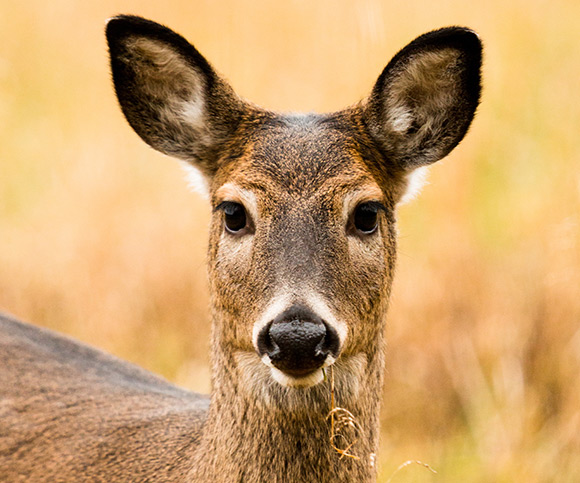
Doe deer - Anthony Roberts/Unsplash photo
Following confirmation of a positive test sample for chronic wasting disease (CWD) in a road-killed 4.5-year-old female whitetail in Holmes County, two Florida state agencies have implemented an emergency response plan. The Florida Fish and Wildlife Conservation Commission (FWC) and the state’s Department of Agriculture and Consumer Services (FDACS) have implemented comprehensive management actions and an executive order to protect against the possible spread of CWD. The FWC executive order establishes a CWD Management Zone around the positive sample. This includes portions of Holmes, Jackson and Washington counties north of Interstate 10, east of State Road 81 and west of U.S. Highway 231. In this zone, exporting whole deer carcasses and high-risk carcass parts (brain and spinal cord) is prohibited. No baiting or feeding of deer is allowed in the zone, with limited exceptions. Also, rehabilitating or releasing injured or orphaned whitetails is prohibited. Meanwhile, a quarantine for all captive cervid facilities in the zone will take place, along heightened review of transportation permits for captive cervids to or from captive cervid facilities within the zone.
FWC will also collect samples from specific established zones to further assess the spread of the disease. The results of these samples will inform resource managers, so they can respond with appropriate management strategies. FWC has increased CWD monitoring and surveillance in the area and FDACS is prioritizing CWD testing from all samples collected from Holmes County.
The purpose of these regulations is to help protect Florida’s whitetail herd by reducing the potential spread of CWD within the zone and to other parts of the state. The first case of CWD in North America was described in mule deer in Colorado in 1967. Florida is the most recent of 31 states to detect the disease, which also has been confirmed in four Canadian provinces, Finland, Norway, Sweden and South Korea. The FWC has been monitoring free-ranging deer since 2002 to detect CWD. During that time, the FWC has tested approximately 17,500 hunter-killed, road-killed and sick or diseased deer for CWD. The FWC is asking anyone who sees a sick, abnormally thin deer or finds a deer dead from unknown causes to call the CWD hotline, 866-CWD-WATCH (866-293-9282) and report the animal’s location.
In Oklahoma, a second wild white-tailed deer has tested positive for chronic wasting disease (CWD). The deer was located about 15 miles east of Woodward in Woodward County after a landowner reported the deer behaving abnormally. Oklahoma's first case of a wild deer infected with CWD was confirmed the first week of June in Texas County, prompting the activation of the next stage in the state's CWD Response Strategy jointly produced by the Oklahoma Department of Wildlife Conservation and the Oklahoma Department of Agriculture, Food and Forestry. “We will be working through our response plan implementing surveillance efforts and steps to monitor and slow the potential spread of this disease. Our ultimate goal is to ensure healthy and well-managed deer with as little impact to either the resource or our constituents as possible,” said Jerry Shaw, Wildlife Programs Supervisor with ODWC.
The Wildlife Department has conducted CWD monitoring on hunter-harvested deer and elk, and road-killed deer, since 1999. Department staff will continue monitoring for evidence of CWD within Oklahoma’s borders and will release additional information, including ways deer and elk hunters can help with detection and mitigation, as hunting seasons approach. For more information on the disease, hunting regulations, and proper disposal of infected animals, go to https://www.wildlifedepartment.com/hunting/resources/deer/cwd.
California, North Dakota duck numbers up
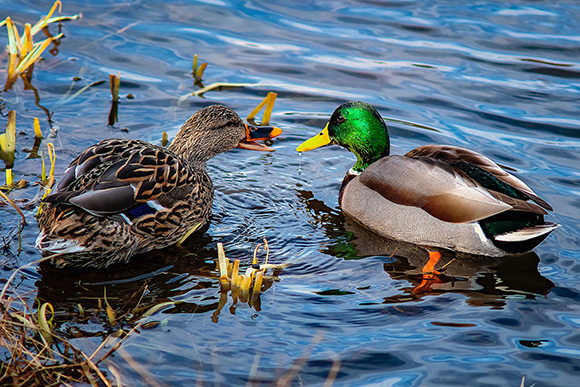
Mallards - Robert Thiemann/Unsplash photo
When the California Department of Fish and Wildlife (CDFW) completed its 2023 waterfowl breeding population survey, the results showed a 30% increase, with mallards – up 13% – leading as the most abundant duck.
More surface water improved habitat, CDFW’s Waterfowl Program Biologist Melanie Weaver noted. Combined, ducks increased from 379,870 in 2022 to 495,438 this year, still 8% below the long-term averages. The estimated breeding population of mallards increased from 179,390 in 2022 to 202,108 this year, also below the long-term average. Long-term declines are largely attributed to the loss of nesting habitat. The full Breeding Population Survey Report is available at https://wildlife.ca.gov/. CDFW biologists and warden pilots have conducted this survey annually using fixed-wing aircraft since 1948. The majority of California’s wintering duck population originates from breeding areas surveyed by U.S. Fish and Wildlife Service (USFWS) in Alaska and Canada, results available by August.
Also, North Dakota duck numbers were up slightly.
The North Dakota Game and Fish Department’s 76th annual spring breeding duck survey conducted in May showed an index of more than 3.4 million birds, up 1.5% from last year. This was 39% above the long-term (1948-2022) average, according to Mike Szymanski, migratory game bird supervisor. However, Szymanski noted that all May waterfowl surveys count what remains of the previous year’s fall flight, which had modest reproduction, resulting in relatively flat duck numbers. He also noted a large decrease in the number of ducks observed in areas with good wetland conditions, such as the Drift Prairie. This is emblematic of an overall decline, he said. Waterfowlers shouldn’t expect the big fall flights of birds seen between 1994 and 2016. Also, wetlands lost ground, down 26% from last year, but remained 76% above the 1948 - 2023 average. Heavy snow last winter resulted in the seventh wettest spring on record – evidence of a highly dynamic prairie wetland ecosystem. Wet or not, Szymanski noted, waterfowl continue to decline due to lack of secure nesting cover.
While most duck numbers were up, blue-winged teal (-4%), mallards (-9.8%) and scaup (-23%) declined. However, green-winged teal were up 71%, wigeon up 58%, shovelers up 12%, canvasbacks 19% and pintails up 47%. Szymanski was particularly happy to see pintails, a species of management concern, increase. He believed pintails responded to improved nesting conditions. Breeding duck numbers in North Dakota generally trend with wetland conditions, Szymanski said. Unless upland nesting habitats improve, the Dakotas won’t be able to buoy midcontinent duck populations without large acreages perennial grasses provided by programs like CRP.
Vermont Junior Waterfowl Hunter Training Program
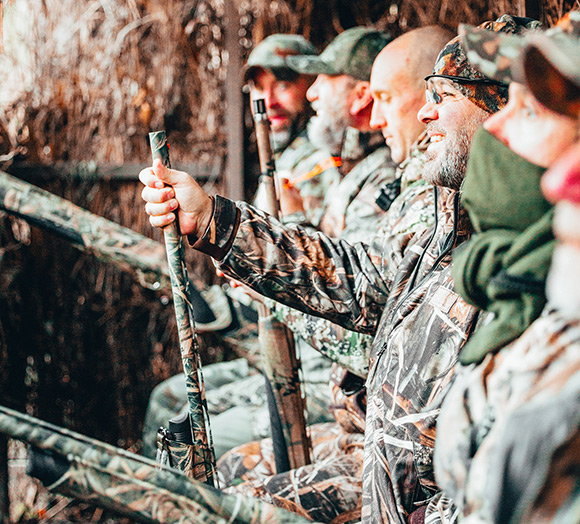
Waterfowlers in a blind - Aaron James/Unsplash photo
The Missisquoi National Wildlife Refuge, in Franklin County, Vermont, will host a Junior Waterfowl Hunter Training Program on Saturday, August 19, via the U.S. Fish and Wildlife Service, Vermont Fish and Wildlife Department, Ducks Unlimited, Delta Waterfowl and the Sportsman’s Club of Franklin County. This opportunity is being offered to hunters ages 12 to 17 who have an adult waterfowl hunter to serve as a mentor and want to learn more about waterfowling. The program focuses on the knowledge and skills necessary to become responsible, respected hunters who learn all they can about waterfowl and to become knowledgeable in firearms safety, hunter ethics and wildlife conservation. Mentors and youths who would like to participate must pre-register with the refuge by Friday, August 4. Participation is limited to 30 students. All mentors and young hunters must attend the one-day training session, rain or shine, on Saturday, Aug. 19, with instruction beginning at 8 a.m. at the Franklin County Sportsman’s Club on Route 36, Maquam Shore Road, in St. Albans. All youth should bring the shotgun they intend to use for hunting to the training. Junior Hunters and their mentors, after completing the training, receive exclusive use of several premier hunting areas on the refuge for the first four weekends of waterfowl season. To register, call refuge headquarters at (802) 868-4781.
Oklahoma Waterfowl Stamp Art Entries Due Aug. 31
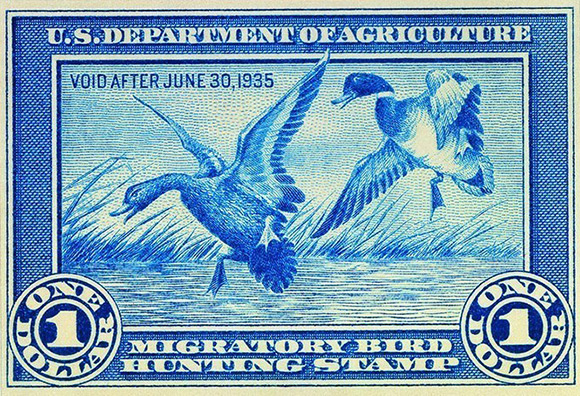
The first United States duck stamp, issued in 1934, by Jay N. "Ding" Darling, head of the U.S. Biological Survey, Department of Agriculture
For the past 42 years, Oklahoma has conducted an annual Waterfowl Stamp Design Contest to celebrate great artwork and to raise funds for wetland habitat projects. This year’s duck stamp contest is under way, and all entries are due by August 31. Any artist is eligible to enter artwork. Gadwall ducks are this year’s subject. The winning artwork will become the design for the 2024-25 Oklahoma Waterfowl Stamp, which can be purchased by state waterfowl hunters and stamp collectors nationwide. The winning artist will receive a $1,200 purchase award. Since the stamp program began, 12,000 acres of habitat has been purchased and many thousands of acres of habitat has been enhanced, restored and maintained for the benefit of waterfowl. After the entry period closes Aug. 31, public voting will take place online and count as part of the scoring. Wildlife Department judges will consider each artwork in terms of anatomical accuracy, artistic composition and suitability for printing. For complete rules, visit www.wildlifedepartment.com/hunting/resources/waterfowl/duck-stamp-program.
Missouri Archers Invited to Compete

Kid shooting bow - Norbert Braun/Unsplash photo
The Missouri Department of Conservation (MDC) and the Missouri Conservation Heritage Foundation (MCHF) invite young archers to compete at the new Open Outdoor 3D Archery Tournament, Aug. 12, at Mark Twain Lake Archery Park, in Monroe City. The event is a one-day, family-friendly fundraiser to support youth archery and outdoor programs. Archers of all ages and shooting levels are invited to attend the tournament. Multiple divisions and categories will be available, including bowhunters, traditional, compound, and bare bow. With two ranges, 40 total targets and fun challenge games, there’s fun to be had by all. The Open Outdoor 3D Archery tournament is sponsored by MDC, MCHF, the U.S. Army Corps of Engineers, and the Mark Twain Lake FOREST Council. Pre-registration closes Aug. 5 at 5 p.m. To learn more and register, visit https://mochf.org/3d-archery-tournament/.
Pennsylvania Turkey Survey
.jpg)
Audubon turkey drawing.
The Pennsylvania Game Commission wants the public’s help with the annual Wild Turkey Sighting Survey currently underway through Aug. 31. The survey allows the agency to determine wild turkey productivity, compare long-term reproductive success within Pennsylvania, track population trends and model the turkey population. Turkey sightings can be reported through the Game Commission’s website https://pgcdatacollection.pa.gov/TurkeyBroodSurvey. Participants are asked to record the number of wild turkeys seen, the county, township, wildlife management unit (WMU), date and contact information if agency biologists have any questions. Participants may also simply drop a “pin” into the online the map for the location. Participants should report all turkeys seen, whether gobblers, hens with broods, or hens without broods, said Game Commission Turkey Biologist Mary Jo Casalena. Many factors, including spring weather, habitat conditions, previous winter food abundance, predation and last fall’s harvest affect wild turkey productivity. Statewide, reproductive success was above average (3.1 poults per hen) in 2021 and 2022. At the WMU level, reproductive success in 2022 either improved or was similar to the previous three-year average in 17 of 23 WMUs. It declined to below the previous three-year average in six WMUs -- 3A, 3B, 3C, 4C, 5D and 2D.
Pryor Mountains Grizzly Sighting Confirmed
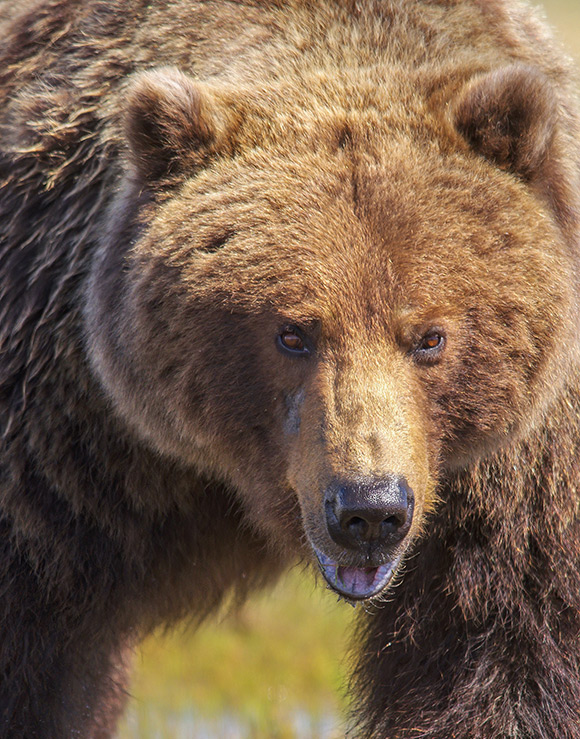
Grizzly - Bob Brewer/Unsplash photo
The first confirmed sighting of a grizzly bear recently took place in the Pryor Mountains, located in Carbon and Big Horn counties in eastern Montana. State wildlife officials confirmed the grizzly from a photograph. Previous sightings of grizzlies in the Pryor Mountains were reported in recent years but remained unconfirmed. Historically, grizzly bears occupied most of Montana, including the Pryor Mountains. But the bears have not inhabited the mountains since the late 1800s. Grizzly bears are federally protected under the Endangered Species Act in all lower 48 states. A healthy black bear population also lives in the Pryors. Wildlife officials contacted area landowners to alert them and provide information on bear conflict prevention. Game cameras were installed in the area. Officials searched for additional bear sign, specifically hair for DNA testing to determine the grizzly bear’s origin.
Anyone recreating in the Pryor Mountains should follow bear safety protocols:
• Carry bear spray and know how to use it.
• Stay alert and look for bear sign – tracks, scat, diggings, torn up logs, carcasses, daybeds and overturned rocks – especially where visibility is limited.
• Avoid traveling at dawn, dusk or night when bears are most active.
• Make human-associated noises, such as shouting and talking to alert bears of your presence.
• Travel in groups and keep members together.
• Never store food or other scented items in tents while camping.
• Avoid animal carcass sites.
Landowners should also remove attractants like garbage, bird seed, pet food, grills and protect livestock with an electric fence. For more information on bear safety, visit https://fwp.mt.gov/conservation/wildlife-management. For any bear conflicts or concerns, contact Daniel McHugh at dmchugh@mt.gov or (406) 850-1131.
Florida nabs nearly 100 impaired boaters during Operation Dry Water

Don't drink and boat. - Marvin Maduro/Unsplash photo
During July 1 – 3, Florida Fish and Wildlife Conservation Commission (FWC) officers arrested 94 vessel operators for boating under the influence of alcohol or drugs, as a part of Operation Dry Water, now in its 15th year. “Tragic accidents occur when irresponsibility is present,” said Col. Brian Smith, Director of FWC’s Division of Law Enforcement. “Operating a vessel while impaired puts the vessel operator, everyone on board and everyone around them in danger. I have no doubt that the hard work our officers and partner agencies put in over the holiday weekend saved lives.” Operating a vessel while under the influence of alcohol or drugs is illegal on all bodies of water and can lead to serious injuries and consequences. In Florida, it is illegal to operate a vessel with a blood alcohol content of .08 or higher, the same as in a vehicle. Operation Dry Water is a year-round Boating Under the Influence awareness campaign that facilitates a national weekend of BUI detection and enforcement aimed at reducing the number of alcohol- and drug-related boating incidents and fatalities.
Woman Punches Bear
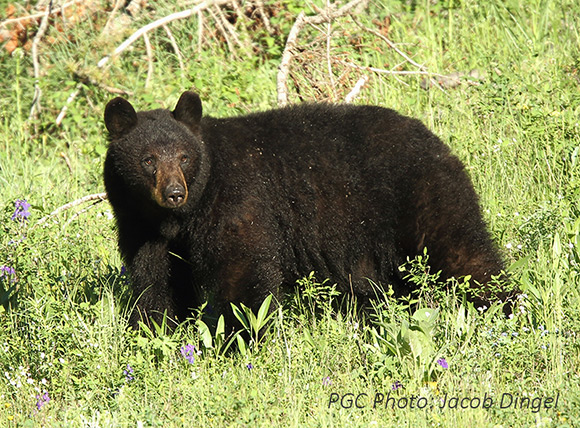
Woman punches Maine black bear, gets bit.
The Maine Warden Service is investigating a late June incident where a black bear bit a Porter woman after she punched the bear. At 11:30 a.m., 64-year-old Lynn Kelly, of Porter, was working in her backyard garden when her dog started barking and took off into the woods. Kelly heard her dog continue to bark then yelp. When she went to investigate, her dog came running out of the woods, chased by a black bear. Kelly confronted the bear head on, and when the bear stood up, Kelly stood up as tall as she could and punched the bear in the nose. The bear then bit her right hand, puncturing her wrist. The bear immediately released her wrist, then ran back into the woods, leaving Kelly and her unharmed dog behind. Kelly called 911 and was transported to Memorial Hospital in North Conway by ambulance, where she was treated for puncture wounds to her wrist. The bear had been seen in previous days in nearby yards eating birdseed that had been left outside but was not seen since the provoked attack. MWS set two live-capture culvert-style traps to capture the bear. The state Department of Inland Fisheries and Wildlife reminds people that black bears can be found throughout the state, and to remove potential wildlife attractants – like bird feeders, bird seed on the ground, unsecured garbage, pet food, even barbecue grills – from your yard. Also, dog owners are urged to walk the dog on a non-retractable leash. If you see a bear, turn around and leave.
Study detects PFAS in 45% of tap water

Chemicals in tap water. - Engin Akyurt/unsplash photo
At least 45% of the nation’s tap water is estimated to have one or more types of the chemicals known as per- and polyfluorinated alkyl substances, or PFAS, according to a new study by the U.S. Geological Survey. There are more than 12,000 types of PFAS, not all of which can be detected with current tests; the USGS study tested for the presence of 32 types. PFAS are a group of synthetic chemicals used in a variety of common applications, from the linings of fast-food boxes and non-stick cookware to fire-fighting foams and other purposes. High concentrations of some PFAS may lead to adverse health risks in people, according to the U.S. Environmental Protection Agency. Research is still ongoing to better understand the potential health effects of PFAS exposure over long periods of time. Because they break down very slowly, PFAS are commonly called “forever chemicals.” Their persistence and prevalence across the country make them a unique water-quality concern.
This USGS research marks the first time anyone has tested for and compared PFAS in tap water from both private and government-regulated public water supplies on a broad scale throughout the country. The data collected was used to model and estimate PFAS contamination nationwide and help the public understand their risk of exposure.
"USGS scientists tested water collected directly from people’s kitchen sinks across the nation,” said USGS Research Hydrologist Kelly Smalling, the study’s lead author. “The study estimates that at least one type of PFAS – of those that were monitored – could be present in nearly half of the tap water in the U.S. Furthermore, PFAS concentrations were similar between public supplies and private wells.” The study tested for 32 individual PFAS compounds using a method developed by the USGS National Water Quality Laboratory. The most frequently detected compounds in this study were PFBS, PFHxS and PFOA. The interim health advisories released by the EPA in 2022 for PFOS and PFOA were exceeded in every sample in which they were detected in this study. Scientists collected tap water samples from 716 locations representing a range of low, medium and high human-impacted areas. The low category includes protected lands; medium includes residential and rural areas with no known PFAS sources; and high includes urban areas and locations with reported PFAS sources such as industry or waste sites.
Most of the exposure was observed near urban areas and potential PFAS sources. This included the Great Plains, Great Lakes, Eastern Seaboard, and Central/Southern California regions. The EPA regulates public water supplies, and homeowners are responsible for the maintenance, testing and treatment of private water supplies. Testing is the only way to confirm the presence of these contaminants in wells. For more information, visit the EPA’s website on addressing PFAS, https://www.epa.gov/pfas/key-epa-actions-address-pfas.
Help Stop the Spread of Invasives
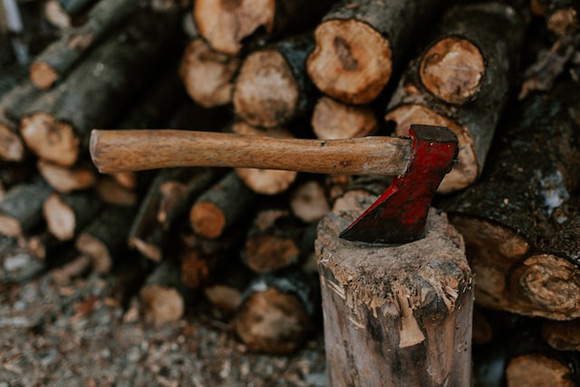
DNR recommends steps to keep invasives from spreading. - Alexei Scutari/Unsplash photo
The Wisconsin Department of Natural Resources (DNR) asks the public to take simple precautions to avoid spreading invasive, nonnative plants and animals in woods, waters and land. Invasive species are nonnative plants, animals and diseases that cause great ecological, environmental or economic harm. Some have already been found in the state, others pose a large risk of surviving and causing problems if introduced. The state’s invasive species rule makes it illegal to possess, transport, transfer or introduce certain invasive species in Wisconsin without a permit.
To prevent the establishment and spread of invasives, the DNR offers the following tips:
-Hikers and campers should clean mud and dirt off their shoes and remove seeds and burs from their clothing before visiting other places to prevent moving invasive plants to new areas via seeds.
-Firewood is a significant pathway for the movement of many invasive insects and pathogens, like the emerald ash borer, spongy moth and oak wilt disease. Use local firewood to avoid moving pests to new places.
-Anglers and boaters can protect vulnerable areas from aquatic invasives like quagga and zebra mussels, Eurasian water milfoil, New Zealand mud snails and Asian clams by cleaning equipment and gear after every use. Inspect gear for dirt, mud, seeds and other debris and remove as much as possible.
-Drain all water from gear before leaving a site and wash it with 140-degree water or steam to remove invasives too small to see. Drying gear for five or more days between use also helps destroy invasive organisms.
-Gardeners can look for and remove potential problem plants, like purple loosestrife, hairy willow herb, butterfly dock, yellow iris, nonnative phragmites (common reed), lesser celandine, water hyacinth, water lettuce and frogbit.
For more information, visit https://dnr.wisconsin.gov/topic/Invasives.
Coming in September FUR-FISH-GAME
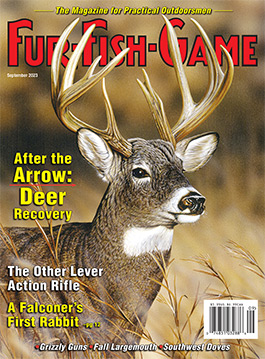
After The Arrow - Jeffrey Miller looks at what happens after a bowhunter releases the arrow, and using examples, discusses some tactics to help bowhunters recover deer.
Apple Kabob Muskrats - Doug Olson follows his grandfather’s footsteps to run a muskrat trapline in Rice Lake WMA prior to freeze-up. Olson uses apples and some lure to make his catch.
Hunting On the Wing - Kevin Shepherd shares the story of his entry into the world of falconry with his first hawk, a red-tailed hawk named Loretta, named to honor Loretta Lynn.
The Other Lever Action Rifle - Randy D. Smith looks at how, for more than a century, the lever action rifle was America’s choice for big game hunting and examines hunting for a number of species with two modern, magazine fed lever guns.
Two Bulls in Five Days (Part I of a two-part story) - Joe Cella shares the story of how he and two other archery hunters embarked on a DIY elk hunt in prime Colorado elk territory and tagged two bulls in five days.
Other stories in September include:
• Southwest Dove Hunting – A look at dove hunting in Texas, Arizona and New Mexico
• September Rivers Double Bill – Walleyes and smallmouth bass on Northeastern rivers
• Portable Culvert Set – How to use construction culvert material to create pocket sets for coons & mink.
• September Teal – How to find the “best eating of all waterfowl” and put birds into your decoys.
• Adirondack Walk-Through Cubby – A look at the famous cubby set and how to make it.
End of the Line Photo of the Month
Wayne Theising, Saint Croix, Indiana
SUBSCRIBE TO FUR-FISH-GAME Magazine

